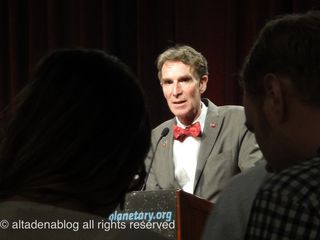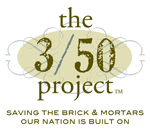10:31 PM PDT: Planetfest attendees at the Pasadena Convention Center learn that the Mars Rover Curiosity had safely landed. Cheering crowd of 2,000, with live video from mission control at the Jet Propulsion Lab in the background. An overflow crowd of 1,000 watched in the Civic Auditorium next door. Video by Laura Monteros.
Seven minutes of terror, 14 minutes of jubilation: a night to remember at Planetfest
by Laura Monteros
Seven minutes of terror: seven minutes between the time the Mars Science Lab capsule entered the Mars atmosphere and the MSL team at JPL learned whether the rover Curiosity had safely landed.

Fourteen minutes of jubilation: 14 minutes of nonstop cheering in the Pasadena Convention Center, as the Planetfest crowd heard the news that Curiosity had set all six wheels on the surface of the Red Planet at 10:31 p.m. PDT on Monday. Punctuated by photos flashing onto the screens and urged on by Bill Nye and Bruce Betts of The Planetary Society, 2,000 people in the ballroom and another 1,000 at the Pasadena Civic Center chanted “JPL! JPL!”
The folks at JPL, that real-life sci-fi community nestled at the top of the Arroyo Seco, had done it again, and we were there to catch it live.
Well, not quite live, since the signal took 14 minutes to get to earth, but live for us, and as exciting as all get out. Scientists and engineers embraced each other, folks at the Convention Center high-fived strangers, and the orbiter Odyssey outdid itself by relaying not the “maybe one” photo that was promised, but four splendid, spectacular shots.
Preparing for news of the descent, and excited Nye, CEO of The Planetary Society said, “My friends, this is a shared experience. This is humankind at its very best.” Chief engineer Rob Manning warned people not to get too excited if the rover was silent, since Odyssey was positioned to relay tones as the spacecraft passed different milestones in its descent, but would be out of range soon after landing.
The difficulty of the mission was underscored by Doug McCuistion, director of the NASA Mars Exploration Program and Matt Golombek, Mars Exploration Program Landing Site Scientist. McCuistion said, “The landing system has never been tested one end to the other.”
Golombek noted that choosing a landing site, in Curiosity’s case, the Gale Crater, is always a tension between someplace safe and someplace interesting. “Engineers worry about anything sticking out of the ground,” he said. “Scientists want to go to the coolest place.”
Word came from the JPL mission control center at 10:14 p.m., “We’re hearing heartbeat tones at this time. Things are looking good.”
The mood as earth waited was both tense and excited.
At 10:24, the first tone, indicating the spacecraft had entered Martian atmosphere, sounded. “It’s heading directly for its target,” control said. The crowd cheered and waved with more excitement than the Olympics.
The supersonic parachute, designed to slow down the craft, deployed on schedule, and next the lander with Curiosity separated from the back shell, the sky crane lowered the rover, the camera started snapping, and history was made.
“We changed the world, everybody!” Nye yelled over the crowd as the first picture uploaded. “This is humans at their very best!”
Pictures of the rover’s wheels and its shadow showed that the position was perfect. “If this were a gymnast, they stuck the landing,” Nye said. “We must all remember this.”
Planetfest was hosted by the Pasadena-based Planetary Society, and coordinated with events around the world. During the event, feeds came from Toronto, Australia, and Times Square. The Space Association of Australia took us on a tour of their facility using a tablet camera, which they then graciously rotated 180 degrees so we could recognize them better. Toronto related, “We’re playing with remote control rovers. doing egg drops, and drinking quite a bit, actually.” Times Square just screamed and waved.
The landing was not the only event at Planetfest. In addition to the landing, Bruce Betts, director of projects for The Planetary Society, emceed a day of talks and questions in the Convention Center ballroom.
In a tribute to Ray Bradbury, who was to have recorded a greeting, Executive Director Emeritus Louis Friedman relayed what Bradbury had told him he would say: “HOORAY!” Actor and TPS advisory council member Robert Picardo read two of Bradbury’s poems.
Displays included a full-size model of Curiosity, a mockup of the XCOR Lynx sub-orbital vehicle, a privately-built vessel that will replace the space shuttle, the SpaceX Dragon capsule, hands-on activities and video games for kids and (and adults), and a space-themed art show.
We spoke with one of the artists, Rick Sternbach (whose name means “starstream” in German). “I grew up watching Sci-Fi movies as a kid in the ‘50s,” he said. There was nothing in orbit at the time, but when the Mercury and Gemini missions came along, something just clicked for him, and Apollo 11 was especially exciting.
“I watched it all happen,” he said. He had just graduated from high school, and he told his parents, “I’ve got a couple of bucks, I’ve got to go to Florida.” He stood nine miles from the launch pad. Later, he got press credentials to attend the Apollo 13 launch. Since then, he’s combined his engineering training with art. He designed Voyager and Deep Space 9 for the Star Trek shows.
The Planetary Society mission is to “Create a better future by exploring other worlds and understanding our own.” TPS “sponsors projects that will seed innovative space technologies, nurture creative young minds, and be a vital advocate for our future in space.”






